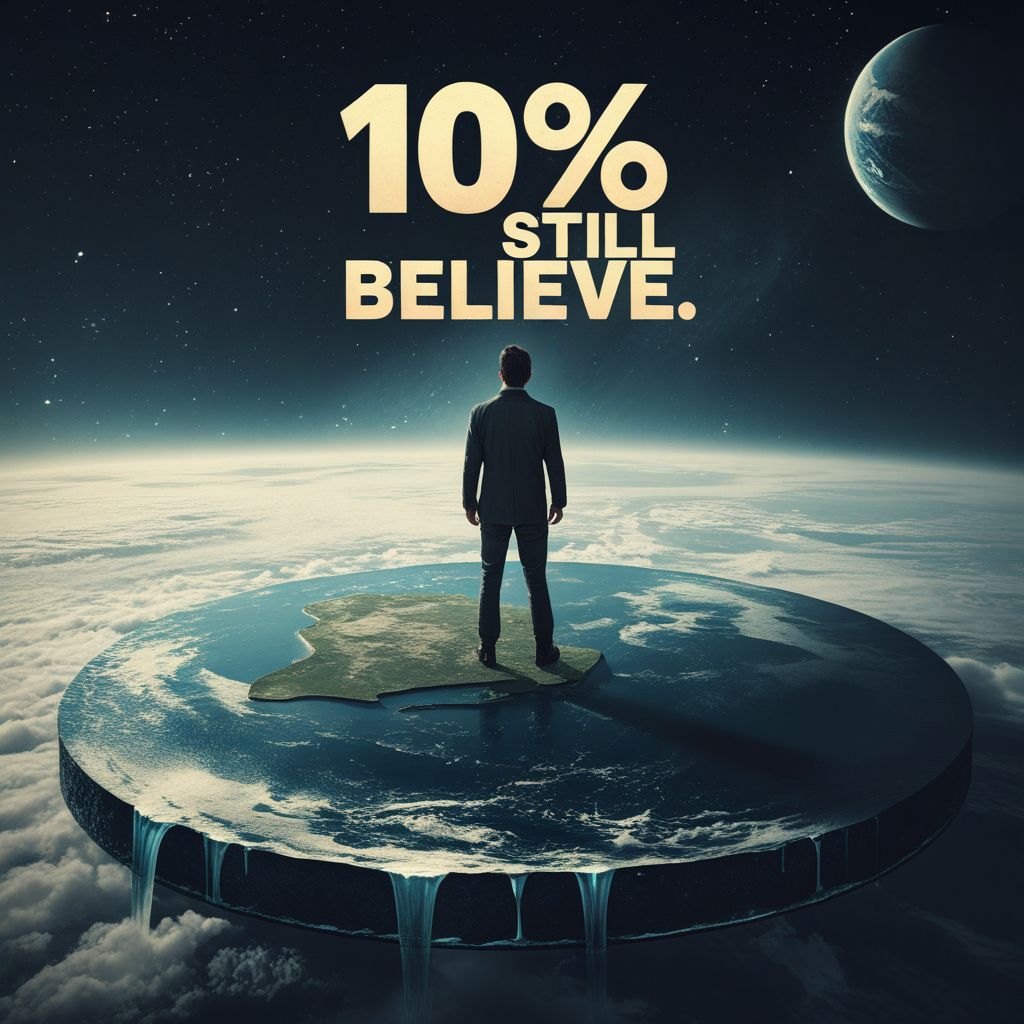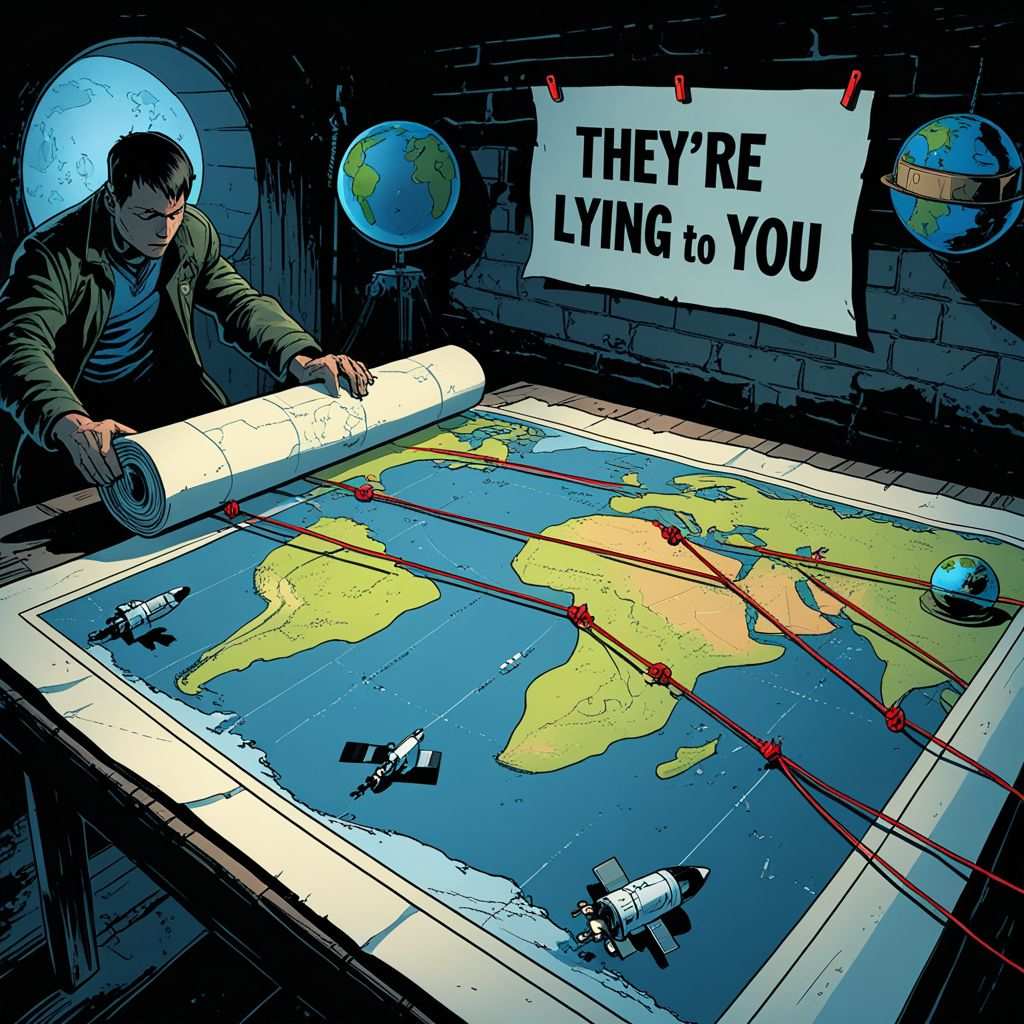Why 10% of Americans Believe the Earth Is Flat— and the Reason Is Wild

Despite live footage from the International Space Station and centuries of scientific consensus, nearly 1 in 10 Americans still believe the Earth is flat. In an era of Google Maps and Mars rovers, this ancient idea has made a shocking modern comeback. But this isn’t just about ignoring science — it’s about deep mistrust, intuitive thinking, and a craving for simple truths in a complex world. As bizarre as it sounds, the flat Earth theory tells us more about human psychology than planetary shape. And the real reason behind it is wilder than you think.
To understand the allure of the flat Earth theory, we can look at the curious case of “Mad Mike” Hughes, a limousine driver turned amateur rocket scientist. Mike gained notoriety for his audacious, self-funded attempts to launch himself into space in homemade rockets. His initial crowdfunding efforts for these stunts largely failed, but his fortunes changed dramatically when he declared his true motivation: to personally verify if the Earth was indeed flat. This declaration resonated deeply with the Flat Earth community, transforming him from an eccentric daredevil into a reluctant hero, and providing him with the financial backing he needed. Mike’s story, while tragic in its conclusion, highlights a key aspect of this belief system: a profound distrust of conventional science and a reliance on personal observation, no matter how flawed.

The Enduring Myth: A Brief History of Flat Earth Beliefs
While the modern flat Earth movement might seem like a recent anomaly, the concept of a flat Earth is an ancient one, prevalent in many early civilizations. However, the idea of a spherical Earth has been understood and accepted by scholars for millennia. As early as 500 BC, the Greek philosopher Pythagoras, observing the spherical shapes of the Sun and Moon, intuited that the Earth too must be spherical. Later, around 350 BC, Aristotle provided empirical evidence, noting the round shadow cast by the Earth during lunar eclipses and the way ships gradually disappear hull-first over the horizon, indicating a curved surface.
Further scientific advancements solidified this understanding. Around 200 BC, Eratosthenes famously calculated the Earth’s circumference with remarkable accuracy by observing shadows at different locations. By the 1600s, with the advent of figures like Isaac Newton, the spherical nature of Earth was widely accepted and no longer a subject of serious scientific debate. The evidence was overwhelming and consistently reinforced by observation and calculation.
However, the 19th century saw a resurgence of flat Earth ideas, largely spearheaded by Samuel Rowbotham. In 1865, he published “Zetetic Astronomy: Earth Not A Globe,” a book that became a foundational text for modern flat Earth proponents. Rowbotham’s arguments were based on what he termed a “Zetetic” approach, emphasizing direct observation over scientific theory. He argued that since horizons appear flat, and bodies of water don’t visibly curve, the Earth must be flat. He proposed a model where the North Pole is at the center, and Antarctica forms an ice wall around the disc-shaped Earth, preventing oceans from spilling off. This seemingly simple, intuitive explanation appealed to those who distrusted complex scientific explanations.
The Modern Flat Earth: Models and Misinterpretations
Today’s flat Earth theories, while rooted in Rowbotham’s ideas, have evolved with various interpretations. The most common model depicts Earth as a flat disc with the North Pole at its center, surrounded by an impenetrable ice wall of Antarctica. Some adherents believe this ice wall is finite, while others contend it extends infinitely. A crucial aspect of their model is how they explain celestial mechanics. They propose that the Sun and Moon are much smaller than commonly believed, perhaps only 50 km in diameter, and orbit the flat Earth at a height of around 5,500 km. Day and night are explained by these celestial bodies acting like spotlights, illuminating only portions of the flat plane as they circle above.

This model, however, struggles to account for many observable phenomena, such as the different seasons, the varying lengths of day and night across the globe, and the existence of time zones. Flat Earthers often resort to convoluted explanations or outright denial of scientific principles. For instance, some propose that sunlight is hot, while moonlight is cold, citing anecdotal observations of temperature differences between day and night as ‘proof.’ Such arguments, while seemingly intuitive to some, lack any scientific basis and ignore fundamental laws of physics.
Beyond scientific misinterpretations, modern flat Earth beliefs often intertwine with religious texts. Proponents frequently misinterpret verses from the Bible and Quran to support their claims. For example, biblical references to the ‘four corners of the Earth’ are taken literally, despite being widely understood as metaphorical expressions for the entirety of the world. Similarly, Quranic verses describing the Earth as ‘spread out as a carpet’ are selectively interpreted to mean perfectly flat, ignoring scholarly interpretations that emphasize the Earth’s vastness and accessibility. This selective reading and literal interpretation of religious texts serve to reinforce their pre-existing beliefs and provide a perceived divine validation for their theories.
The Psychology of Belief: Why the Flat Earth Persists
The persistence of flat Earth beliefs in the face of overwhelming scientific evidence is a fascinating psychological phenomenon. Several factors contribute to this adherence to a disproven theory:
1. Convenience: People are often drawn to explanations that are simple and easy to understand, even if they lack scientific rigor. Complex scientific concepts, with their reliance on data, charts, and intricate theories, can be challenging to grasp. In contrast, a simple, intuitive explanation ‒ like the Earth appearing flat from our perspective ‒ can be more appealing. Furthermore, accepting a convenient lie can alleviate fear or the need for personal change. If global warming isn’t real, for example, there’s no need to alter one’s lifestyle. This avoidance of uncomfortable truths makes convenient explanations particularly attractive.
2. Intuition and Personal Observation: Flat Earth proponents often prioritize their own sensory experiences over scientific consensus. They look around and see a flat horizon, flat bodies of water, and distant objects that remain visible, concluding that the Earth must be flat. They fail to account for the Earth’s immense size, which makes its curvature imperceptible to the naked eye from ground level. This reliance on intuition is often linked to the Dunning-Kruger effect, a cognitive bias where individuals with limited knowledge in a particular area overestimate their own competence. They believe they can conduct their own research and arrive at conclusions superior to those of experts, often leading them to misinterpret observations or ignore crucial scientific principles like atmospheric refraction, which can explain phenomena like the visibility of distant objects.
3. Lack of Critical Thinking: A significant factor in the embrace of conspiracy theories, including the flat Earth, is a deficiency in critical thinking skills. Critical thinking involves questioning one’s own beliefs, considering alternative perspectives, and rigorously evaluating evidence. Flat Earthers often fail to apply this critical lens to their own theories, readily accepting information that confirms their biases while dismissing anything that contradicts them.
The historical example of Samuel Rowbotham’s Old Bedford Level experiment perfectly illustrates this. He observed a flag remaining visible over a six-mile stretch of water and concluded the Earth was flat, failing to consider the complex phenomenon of light refraction. When later challenged and disproven by Alfred Wallace, the flat Earther involved refused to pay, highlighting a resistance to acknowledging flaws in their reasoning.
4.Mistrust of Authority and Institutions: Perhaps the most potent driver of flat Earth belief is a deep-seated mistrust of established authorities and institutions. Flat Earthers often view governments, scientific organizations (like NASA), educational systems, and mainstream media as part of a vast conspiracy to conceal the
truth about the Earth’s shape. They dismiss photographic evidence from space, scientific textbooks, and even the consensus of international space agencies as fabricated. This pervasive skepticism leads them to believe that even geopolitical rivals like the US and Russia would collude in such a grand deception. This level of distrust, while understandable in some contexts, becomes problematic when it leads to the rejection of verifiable facts and the embrace of baseless claims.
Beyond the Horizon: The Dangers of Conspiracy Theories
The flat Earth theory, while seemingly harmless, serves as a gateway to a broader acceptance of other conspiracy theories. The same mindset that leads individuals to believe the Earth is flat often predisposes them to accept other unsubstantiated claims, such as vaccines containing microchips, the moon landing being faked, or the non-existence of gravity and dinosaurs. This interconnectedness of conspiracy beliefs highlights a dangerous pattern: once critical thinking is abandoned in one area, it becomes easier to dismiss evidence and embrace irrationality in others.
This phenomenon is not merely an intellectual curiosity; it has real-world consequences. The case of “Mad Mike” Hughes, who tragically died in a homemade rocket launch, serves as a stark reminder. While he initially used the flat Earth narrative to gain funding, his story ultimately underscores how easily individuals can be misled when they prioritize belief over verifiable facts. His death, a direct result of his dangerous stunts, highlights the potential for harm when individuals operate outside the bounds of scientific understanding and safety protocols.
Moreover, the spread of such theories erodes public trust in legitimate institutions and expertise. When scientific consensus is dismissed as a grand conspiracy, it becomes challenging to address real-world problems that require collective action and trust in expert guidance, such as climate change, public health crises, or technological advancements. The constant questioning of established knowledge can lead to societal fragmentation and a decline in informed decision-making.

A Call for Critical Thinking: Navigating a Complex World
In the end, flat Earth belief isn’t just about the shape of our planet — it’s a mirror reflecting our growing distrust, fractured attention, and need for control in a chaotic world. These theories thrive not because of a lack of information, but because of an overload of it — where loud opinions often drown out quiet facts.
But truth doesn’t care how loudly lies are shouted. It requires curiosity, humility, and critical thinking — not just to understand our world, but to protect it.
If we want to rise above misinformation, we need to stop arguing with absurdity and start promoting reason, evidence, and open dialogue. Because the real danger isn’t that some believe the Earth is flat — it’s that too many have stopped asking questions the right way.


